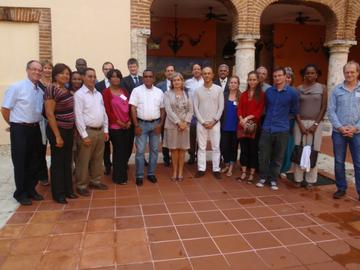2012
The third project coordination meeting was held in the Dominican Republic in December. Two missions have been undertook by the CIRAD and INISAV in Cuba and in The Dominican Republic. The first one focused on the risk of the banana streak virus (BSV) and the second one on the health status of FHIA 21 plantain hybrid.
Aurore Cavalier’s mission to the Dominican Republic
Aurore Cavalier undertook a second mission to the Dominican Republic from 19 April to 29 May 2012. In collaboration with IDIAF, Aurore diagnosed the health status of FHIA 21 plantain hybrids introduced into the Dominican Republic at the end of the 1990s for their resistance to black leaf streak disease. As in Cuba, a decrease in the resistance of these hybrids to the disease has been noted in recent years.
The purpose of Aurore’s mission was to gather data and plant material for analyses, with a view to identifying the reasons for this loss of resistance. Plantain (FHIA 21) leaf samples and soil samples were taken during the mission for nutritional analyses, along with some leaf samples with and without BSV symptoms and, lastly, some scale insect vectors of the virus. Aurore was accompanied in the field by various managers and researchers: Teresa Martinez (IDIAF), Colmar Serra (IDIAF), Ramon Jimenez (IDIAF), Domingo Rengifo (IDIAF), Luis Miniere and Juan Clase (Ministry of Agriculture). In all, 35 FHIA 21 plots were visited and sampled, along with 35 plots planted with a control variety located less than 3 km away from the FHIA21 plots. Only 10 provinces of the territory were sampled, namely those where these hybrids are grown (Monte Cristi, La Isabela, Valverde, Santiago, Espaillat, Hermanas Mirabal, La Vega, Duarte, Monte Plata, and Sanchez Ramirez). A questionnaire survey was also conducted with growers. It was thus possible to describe the environment of the plot and to define the characteristics and associated cultural practices (area, surrounding vegetation, any intercrops, fertilization, origin of the plants, disease severity index, etc.).
The samples collected to determine the nutritional status of the plots were sent to both the CIRAD soil analysis laboratory in Montpellier (France) and to the IDIAF analysis laboratory. The same analyses will be conducted in tandem in the two laboratories, for comparison purposes. In addition, 700 leaf samples were collected for virological indexing (BSV) by IDIAF.
Third coordination meeting, Santo Domingo, 4-6 December 2012
The third project coordination meeting was held at Santo Domingo (Dominican Republic) from 4 to 6 December 2012. The working sessions took place at the French Embassy and IDIAF. Ms B. Kreiss, French Ambassador to the Dominican Republic, gave the opening address in which she stressed the importance of the cooperation between France and the Dominican Republic, particularly in higher education and research.
The progress of the Cabaré project was comprehensively reviewed through presentations of the activities of all participants, thus illustrating the dynamics of each partner and the strong relationships between partners
.
Teresa Martinez’s stay in Guadeloupe as part of her thesis research
Reina Teresa Martinez, coordinator of the Cabaré project for the Dominican Republic, is also conducting thesis research to obtain a PhD at the University of the French West Indies and Guiana within the framework of the project. This research involves assessment of the risk of the banana streak virus (BSV) spreading through the dissemination of interspecific hybrids of banana and plantain carrying endogenous infectious BSV sequences.
Two parent species, i.e. Musa acuminata (A) and Musa balbisiana (B), are used in breeding schemes to obtain new improved interspecific triploid (type AAB) or tetraploid (type AAAB) banana hybrids. However, M. balbisiana parents bear endogenous banana streak virus (eBSV) sequences in their genome. Some of these sequences are infectious and may be expressed following biotic or abiotic stress and lead to infection of the plants. This thesis research is aimed at assessing, on a plot scale via multilocation trials, the risk of banana streak virus (BSV) dispersal through the dissemination of interspecific banana and plantain hybrids carrying infectious endongenous BSV sequences.
R.-T. Martinez was hosted for 2 months at CIRAD-Guadeloupe, from 15 September to 9 November 2012, as part of her PhD research. During this stay, she analysed samples that had been collected in all banana growing areas of the Dominican Republic so as to evaluate the prevalence of the main BSV species. She also analysed the structure of eBSV alleles present in the genotypes targeted in her PhD research. Initial results revealed a close correlation between the presence of infectious eBSV alleles and that of the virus.
The first meeting of her PhD dissertation committee was held during her stay. The committee members include: Graciela Godoy de Lutz (IDIAF, Dominican Republic), Silvina Gonzalez Rizzo (University of the French West Indies and Guiana), Marie-Line Iskra-Caruana (CIRAD-Montpellier),
Rosalba Rodriguez’s stay at CIRAD-Montpellier
Rosalba Rodriguez Pena, IDIAF research engineer, spent 4 months at CIRAD-Montpellier (France). During her stay, she characterized Mycosphaerella fijiensis, black Sigatoka causal agent, in two ways. This fungus was collected at three locations in the Dominican Republic on FHIA 21 (M. fijiensis resistant) and Macho X Hembra (susceptible) varieties. She studied differences in aggressiveness through three successive inoculations of 72 isolates on live banana leaf fragments.
She also participated in describing the genetic diversity of these populations using 11 microsatellite markers. These genetic analyses led to a description of the genetic diversity (HE), allelic richness (Ar) and genetic differentiation (TVF) using Genepop software. The preliminary results suggest that there are now major genetic differences in the pathogen populations.
The meeting also provided an opportunity for partners to review the initiatives planned for 2013. It was agreed that the first experimental plots would be set up in the partner countries in the second half of 2013. The administrative and financial aspects were discussed, including the terms of payment of subsidies to partners to enable them to set up local experiments as quickly as possible.
Damien Meyer (CIRAD-Guadeloupe) and Pierre-Yves Teycheney (CIRAD-Guadeloupe, thesis supervisor).
Published: 12/02/2014

